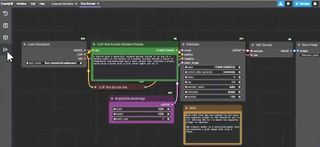Veteran image and video generation frontend ComfyUI has released a new beta version of its first desktop app. ComfyUI V1 provides a comprehensive framework for creating high-quality AI images using a variety of image and video models.
This release marks the first release of an all-new desktop user interface that moves from an experimenter’s tool to the consumer realm.
Instead of users having to install complex code and configure applications on their computers, new systems offer one-click installation, eliminating all setup hassles.
A variety of standalone download packages are available for Windows, Mac, and Linux, and are designed to get “non-technical users” up and running faster than ever before.
What is ComfyUI?
Introducing the packaged desktop application ComfyUI V1 – Windows (@nvidia), macOS (apple Silicon), Linux – One-click installation for non-technical users – ComfyUI Manager included – Auto-installed Python environment closed beta Join us: https://t .co/JFWz9DgqER pic.twitter.com/Wk1pM5vrUjOctober 21, 2024
ComfyUI is the simplest and most complex tool for generating AI images. You can customize how images are generated, called workflows, by placing nodes in your workspace. It can be simply directed to create images from a prompt, all the way to more complex workflows with overlays and upscaling.
Previously, you had to install numerous components as a web interface, but the new desktop software simplifies the entire setup process by simply clicking a link.
It also comes with a few other perks. The system now automatically provides updates as they arrive from the development team, and each download comes with a complete Python code environment and stable versions of core software options.
What’s new in ComfyUI Desktop?

The ComfyUI team announced many other product feature updates. Experienced users will appreciate the addition of multiple workflow tabs to make it easier to track different workflows while creating high-quality images.
There’s also a new set of custom key bindings to help you adjust your work processes, and a valuable new unified log viewer to debug issues.
Other interface improvements include an improved top menu bar, right mouse click access to the model library, and a quick access workflow browser.
ComfyUI now automatically downloads models if users do not already have them installed for their workflow needs. This is also designed to make the work easier, especially for inexperienced users who may get confused with model selection while working.
What are the alternatives?
Despite the announced changes, there is no doubt that the ComfyUI environment is more suitable for technically minded users.
Alternatives to ComfyUI include the open source Forge environment. This environment has offered one-click installation with Pinokio for some time and uses the more user-accessible Gradio interface for configuring image generation criteria.
Also, ComfyUI still lacks proper image repair capabilities and is inferior to alternatives such as the Automatic1111 image generation interface.
The speed and simplicity of the Gradio interface contrasts with the complex usage patterns of ComfyUI nodes. For those who want to create images with minimal effort, Gradio is definitely the way to go.
However, if you enjoy creating complex and precise image and video generation settings to get the results you want, nothing compares to ComfyUI. `
The new ComfyUI V1 package is currently available only via a beta test waiting list, and interested parties can sign up at comfy.org.


